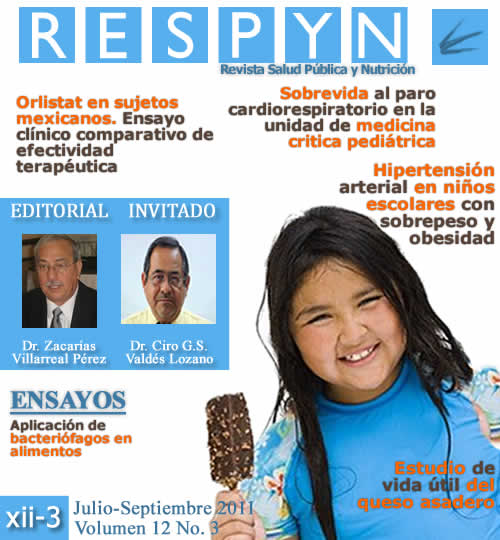ORLISTAT EN SUJETOS MEXICANOS. ENSAYO CLÍNICO COMPARATIVO DE EFECTIVIDAD TERAPÉUTICA
Abstract
El objetivo fue determinar si en sujetos mexicanos con sobrepeso u obesidad el orlistat a dosis de 60mg versus orlistat 120 mg vía oral, conserva la misma eficacia terapéutica y los eventos adversos gastrointestinales esperados son mejor tolerados. Ensayo clínico longitudinal, prospectivo, doble ciego y comparativo, con un periodo de selección de 7 días y otro de tratamiento de 90 días, con asignación aleatoria de los sujetos. La reducción del peso, índice de masa corporal, composición de grasa corporal y parámetros antropométricos fueron estadísticamente significativas al interior de los grupos, pero sin diferencia entre ellos (2.1 vs 1.5 Kg). La mayoría de los eventos adversos gastrointestinales fueron de intensidad leve en ambos grupos. En sujetos mexicanos con sobrepeso u obesidad, el Orlistat a dosis de 60 mg antes de cada comida tiene el mismo efecto en la reducción de peso que la dosis de 120 mg antes de cada comida. Se recomienda su uso en conjunto con la modificación alimenticia y de actividad física.
Abstract
The aim was to determine if in Mexican, overweight or obese subjects, the Orlistat dosed at 60 mg versus Orlistat dosed at 120 mg, both oral, keeps the same therapeutic efficacy and if the gastrointestinal adverse events may be tolerated easier. Longitudinal, prospective, double blind and comparative clinical trial, with a 7 days screening period and a 90 days treatment period with random allocation of subjects. The weight loss, body mass index, body fat composition and anthropometric parameters were statistically significant inside the groups, but without difference between them (2.1 versus 1.5 kg). Most of the gastrointestinal adverse events were mild in intensity at both groups. In Mexican, overweight or obese subjects, the Orlistat dosed at 60 mg before each meal demonstrates the same effect at weight reduction than the 120 mg dose before each meal. It is recommended to use it in conjunction with dietary modification and physical activity.
Palabras clave: Orlistat, sobrepeso, obesidad
Downloads
References
Drew BS, AF Dixon and JB Dixon 2007. Obesity management: update on orlistat. Vasc Health Risk Manag. Vol. 3 No. 6: 817-821.
Filippatos TD, CS Derdemezis, IF Gazi, ES Nakou, DP Mikhailidis and MS Elisaf 2008. Orlistat-associated adverse effects and drug interactions: a critical review. Drug Saf. Vol 31 No. 1: 53-65
Conde JL 2002. Eficacia y efectividad: una distinci ón útil para la práctica y la investigación clínicas. Nefrología. Vol. 22 No. 3: 219-222.
Hauptman J, C Lucas, MN Boldrin, H Collins and Segal K 2000. Orlistat in the long-term treatment of obesity in the primary care setting. Arch. Fam. Med . Vol. 9 No. 2: 160-167.
Anderson JW 2007. Orlistat for the management of overweight individuals and obesity: a review of potential for the 60-mg, over-the-counter dosage. Expert Opin Pharmacother. Vol. 8 No. 11: 1733-1742
Goldstein DJ 1992. Beneficial health effects of modest weight loss. Int J Obes Relat Metab Disord. Vol.16 No. 6: 397-415.
Rössner S, L Sjöström, R Noack, AE Meinders and G Noseda 2000. Weight loss, weight maintenance, and improved cardiovascular risk factor after 2 years treatment with Orlistat for obesity. Obesity Research. Vol. 8 No. 1: 49-61.
Hauptman J, et al, Op cit
Downloads
Published
How to Cite
Issue
Section
License
The rights of the work belong to the author or authors, however, by sending it for publication in the Public Health and Nutrition Magazine of the Faculty of Public Health and Nutrition of the Autonomous University of Nuevo León, they grant the right for its first publication in between electronic, and possibly, in print to the Public Health and Nutrition Magazine. The license used is the Creative Commons attribution, which allows third parties to use what is published whenever the authorship of the work is mentioned and the first publication that is in the Public Health and Nutrition Magazine. Likewise, the author or authors will take into account that it will not be allowed to send the publication to any other journal, regardless of the format. The authors will be able to make other independent and additional contractual agreements for the non-exclusive distribution of the version of the article published in the Public Health and Nutrition Magazine (e.g., institutional repository or publication in a book) provided they clearly state that The work was published for the first time in the Public Health Magazine, Magazine of the Faculty of Public Health and Nutrition of the Autonomous University of Nuevo León.










